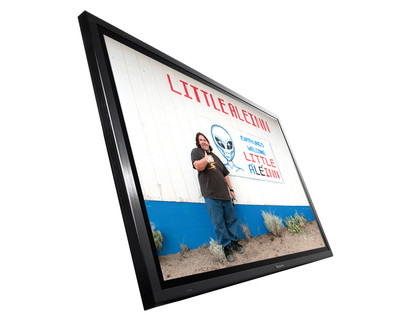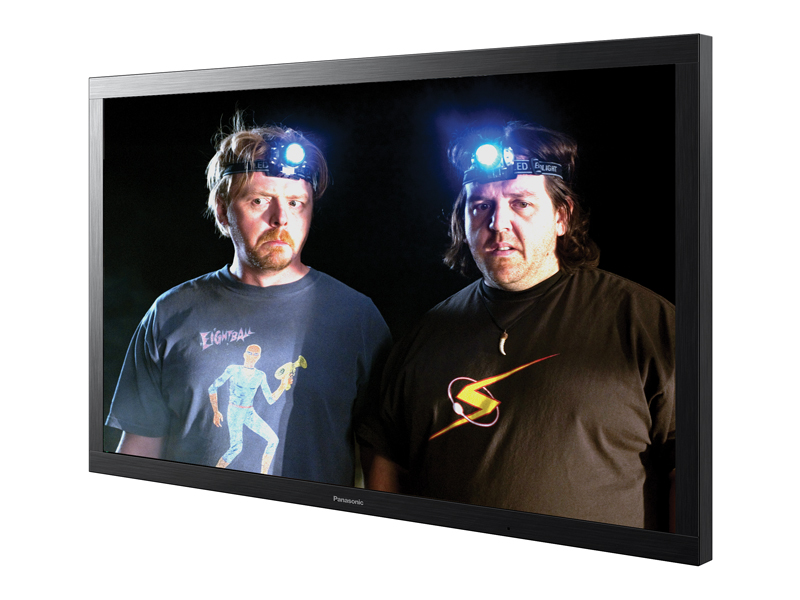Why you can trust TechRadar

If you're as huge as the TH-85VX200, you might as well be unapologetically so. The gargantuan display is clad in a startlingly heavy-duty, metallic black bezel, boasts a rear that could slot in half a dozen of today's slim edge LED TVs and weighs a hernia-guaranteeing 118kg.
You will therefore need a seriously sturdy wall if you fancy wall-hanging and Panasonic's custom-built hydraulic floor mounts are reportedly proving popular with those already fortunate enough to be in possession of a TH-85VX200.
Connections are a mixture of standard stuff and stuff you can add via optional accessory boards. Among the standard options are four HDMI inputs all built to the v1.4 standard for 3D compatibility, a component/RGB RCAx3 input, and a D-Sub PC input.
There is a LAN port, but this is only for control systems. Significantly, the TH-85VX200B doesn't carry Panasonic's Viera Cast online system. Perhaps even more troublingly for some people, it doesn't carry any DLNA, USB or SD card support for multimedia duties and these can't be added via any of the (mostly professional broadcast-minded) extra connection boards. This is not, remember, a TV in the normal sense of the word.
It's probably because of this, too, that there doesn't appear to be any THX preset like you get with the VT20 consumer series.
Don't start to think, though, that the TH-85VX200B is devoid of film-friendly calibration tools. In fact, its Pro nature sees it equipped with more fine tuning tools than Panasonic's normal TVs. Among the options available are a series of white balance presets plus the facility to adjust white balance manually via adjustment bars for the high and low red, green and blue colour segments; a black extension tool; a selection of Gamma presets; and a full colour gamut adjustment complete with a Digital Cinema Colour default mode designed to deliver a colour palette more representative of what you see if you visit a professional digital cinema.
With all these tweaks – and more – available, it's no surprise to find the TH-85VX200B endorsed by pro-calibration group, the Imaging Science Foundation (ISF).
Tucked away in the Setup menu, meanwhile, is an option to adjust the motion processing the set applies to sources, which varies between 24p Smooth Film when watching Blu-rays and Panasonic's Intelligent Frame Creation system when watching non-24p material.
Arguably the most interesting part of the TH-85VX200B's Pro nature, though, comes with its 3D features. For as well as Panasonic's crosstalk-reducing accelerated plasma cell decay technology, found also on the VT20 and GT20 models, the TH-85VX200B carries new Motion Vector Prediction circuitry. This attempts to track movement in and out of the picture, as well as the more normal left/right motion, thus increasing the speed at which the panel can respond to changes in 3D image content to deliver a further boost in clarity.
Also potentially significant to 3D is the TH-85VX200B's ultra-high speed drive system, reckoned to make each plasma cell able to respond almost 75 per cent faster than those of previous Panasonic plasmas.
Given that Panasonic's consumer 3D plasmas are already less troubled by crosstalk than any other 3D TVs, the prospect of this flaw being reduced even further on the TH-85VX200B is mouthwatering.
One final significant bit of number crunching delivered by the TH-85VX200B's professional-level 'brain' is the delivery of 30-bit colour processing, as opposed to the usual 20-bit system – something that should increase tonal accuracy and reduce the potential for colour striping.
The main negative to report in this section is that it seems a bit churlish on Panasonic's part to include only a single pair of active shutter 3D glasses with the screen, but then if someone can afford to spend £42,000 on a screen, a few hundred quid for subsequent pairs of specs ought to be small beer.
Current page: Panasonic TH-85VX200: Features
Prev Page Panasonic TH-85VX200: Overview Next Page Panasonic TH-85VX200B: Picture qualityJohn has been writing about home entertainment technology for more than two decades - an especially impressive feat considering he still claims to only be 35 years old (yeah, right). In that time he’s reviewed hundreds if not thousands of TVs, projectors and speakers, and spent frankly far too long sitting by himself in a dark room.

